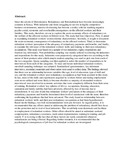| dc.description.abstract | Since the advent of liberalization, Redundancy and Retrenchment have become increasingly common in Kenya. With industries and firms struggling to survive in highly competitive business environments, massive downsizing has become a reality with far reaching negative psycho-social, economic and even health consequences on the affected workers and their families. This study, therefore, set out to explore the socio-economic effects of redundancy on the welfare of the affected workers in Eldoret town.
The study had four objectives. First, it aimed at examining redundant workers' socioeconomic characteristics. Secondly, it sought to document the socio-economic consequences of redundancy on the affected workers. Third, to determine redundant workers' perception of the adequacy of redundancy payments and.benefits, and fmally, to examine the relevance of the redundant workers' skills and training to their post redundancy occupations.
This study was based on a sample of two industries, eighty respondents and fourteen key informants. Non-probability sampling was mainly utilized in selecting the industries and respondents for this study. Industries were purposively categorized into two according to the nature of their products after which simple random sampling was used to pick one from each of the two categories. Quota sampling was then applied to select the number of respondents to be interviewed from each of the categories. To trace and locate individual redundant workers, snowball sampling technique was adopted. Standardized questionnaires, key informant interviews, secondary materials and observation were used to collect data.
The findings showed that there was no relationship between variables like age, level of education, type of skill and sex; and the redundant workers' post redundancy occupations as had been assumed in this study. In fact, most of the skills and experiences acquired by workers before and during employment were never utilized and were likely to become obsolete as majority of retrenched workers interviewed were involved in economic activities that were completely different from their areas of training. Redundant workers' key spheres of life i.e. occupations, housing, education, sanitation and family stability had been adversely affected by loss of income due to retrenchment.
It was also found that redundant workers' perception of the adequacy of their redundancy payments and benefits determined their level of satisfaction with the same, therefore confirming the hypothesis that had been advanced. The study found no relationship between redundant workers' skills and their post redundancy occupations as had been hypothesized.
Based on the findings, two-fold recommendations were put forward: As regards policy, it is recommended that any efforts aimed at addressing the problem of redundancy should first focus on the protection and revival of local industries. This would help stem dismissals and facilitate re-employment of redundant workers. Other efforts should be aimed at redundant workers' compensation, redundancy awareness, trade union representation, training/re-training and job search. T~is is owing to the fact that all these factors are rarely considered whenever redundancies are being effected. Regarding further research, it is recommended that the psychological consequences of job lose for redundant workers are investigated | en_US |

